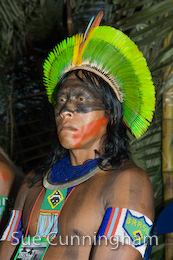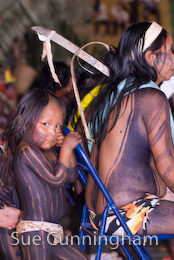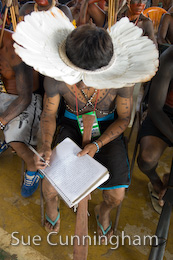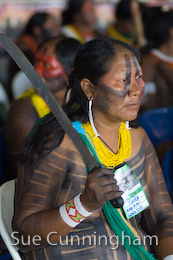Because of the continuing Internet limitations, photos from the last three days of the Encontro will not be uploaded until Sunday or Monday.
 In the afternoon, we visited the seminary where the Indians are being housed during the conference. Tribes which traditionally were at war with each other were huddled together in deep discussion, preparing a joint declaration. Where twenty years ago they were armed with war clubs and machetes, today they wield pens and paper, video cameras and voice recorders.
In the afternoon, we visited the seminary where the Indians are being housed during the conference. Tribes which traditionally were at war with each other were huddled together in deep discussion, preparing a joint declaration. Where twenty years ago they were armed with war clubs and machetes, today they wield pens and paper, video cameras and voice recorders.
Speaking in Portuguese so that all the tribes could understand, several of the younger leaders made impassioned yet articulate presentations, demonstrating a sophisticated understanding of the  economics and politics surrounding the subject. Professor Oswaldo Sevá explained the implications of the construction of dams in greater detail to a silent audience. At the end of his presentation he was regaled with probing questions before being being awarded a Kayapo feather decoration, indicating his acceptance as an honorary member of the tribe.
economics and politics surrounding the subject. Professor Oswaldo Sevá explained the implications of the construction of dams in greater detail to a silent audience. At the end of his presentation he was regaled with probing questions before being being awarded a Kayapo feather decoration, indicating his acceptance as an honorary member of the tribe.
As the discussions proceeded, I had time to reflect on some of the things said during the three days. I realised that, whatever the economic or political pressures driving the Belo Monte project, to move forward with it would be both politically and economically perilous.
 “If the government of President Lula tries to start building Belo Monte, we Kayapo will join together and go to war,” said one chief.
“If the government of President Lula tries to start building Belo Monte, we Kayapo will join together and go to war,” said one chief.
And he means it. If the bulldozers move in, our television screens will be filled with images of Brazilian police firing gas canisters and bullets at angry rows of black-painted Indians. When the first Indian dies, there will be a huge international outcry at the heavy-handedness of the Brazilian authorities, and revulsion from the people of Brazil.
 Later, the chiefs of all the tribes had an audience with the Federal judge who is hearing a case which has paralysed the environmental assessment. In a deposition, they made absolutely clear their opposition to the dams, stating that they would under no circumstances agree to the construction of any dam on the Xingu, citing the irrelevance of monetary compensation for the destruction of their culture and lifestyles.
Later, the chiefs of all the tribes had an audience with the Federal judge who is hearing a case which has paralysed the environmental assessment. In a deposition, they made absolutely clear their opposition to the dams, stating that they would under no circumstances agree to the construction of any dam on the Xingu, citing the irrelevance of monetary compensation for the destruction of their culture and lifestyles.
The rights of Indians are enshrined in the Brazilian constitution of 1988, which says, “Indians shall have their social organization, customs, languages. creeds and traditions recognized, as well as their original rights to the lands they traditionally occupy, it being incumbent upon the Union to demarcate them, protect and ensure respect for all of their property.” It is up to the people and the government of Brazil to uphold their constitution, and hold all of the Indians of the Xingu, their cultures, their ways of life and their lands, inviolate.
The gallery of pictures for day 3:
http://pa.photoshelter.com/c/scp/gallery-show/G0000I9QZ8dN3oRg/
© Patrick Cunningham










